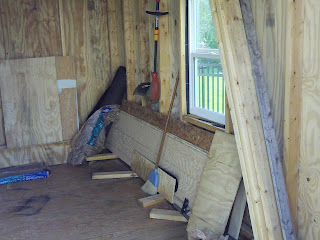To the right of the entry door is room for 2 chairs and a small table. A drop down table attached to the wall would make better use of the space.
At the rear on the same side, I put a 6' x 2.5' table to represent the kitchen area, complete with sink and range. There appears to be enough counter space to make meals. The plywood wall on the right side represents the bathroom wall.
To the left of the entry door, there is room for a couch. This is just a cushion from a piece of patio furniture. The plywood it is resting on is 8' long. If this were an actual tiny house, I would move the door to the long wall, about were the table and chairs are in the previous picture. I would put a big window where the door currently is, and put a pull out couch for sleeping against that 8' wall. That way if the couch was pulled out for someone sleeping, the door on the side would not be blocked for egress.
Between the couch and the bathroom wall I placed a cooler for visualization. I would use this space for a closet or storage area. It could also be part of the bathroom area, as a shower. For a tiny house, I would build a top loading, super insulated cooler into the kitchen cabinets. The top of the cooler would form part of the counter top.
I tacked up a couple of pieces of scrap plywood to represent the bathroom wall. The bathroom area is about 3' x 3'. If a shower is needed, the room could be designed as a wet bath.
Another view of the 'kitchen' from the bathroom area.
I also made a video of what the inside of my SS looks like.
In the future I plan to rig up some 12V LED lights, connected to my deep cycle marine battery. I will update this blog when that happens. I also want to purchase a solar panel and hook it up to charge my marine battery, as an experiment and learning experience.
I may also purchase a little Dickinson Newport wood stove to experiment with heating my shed.


















































